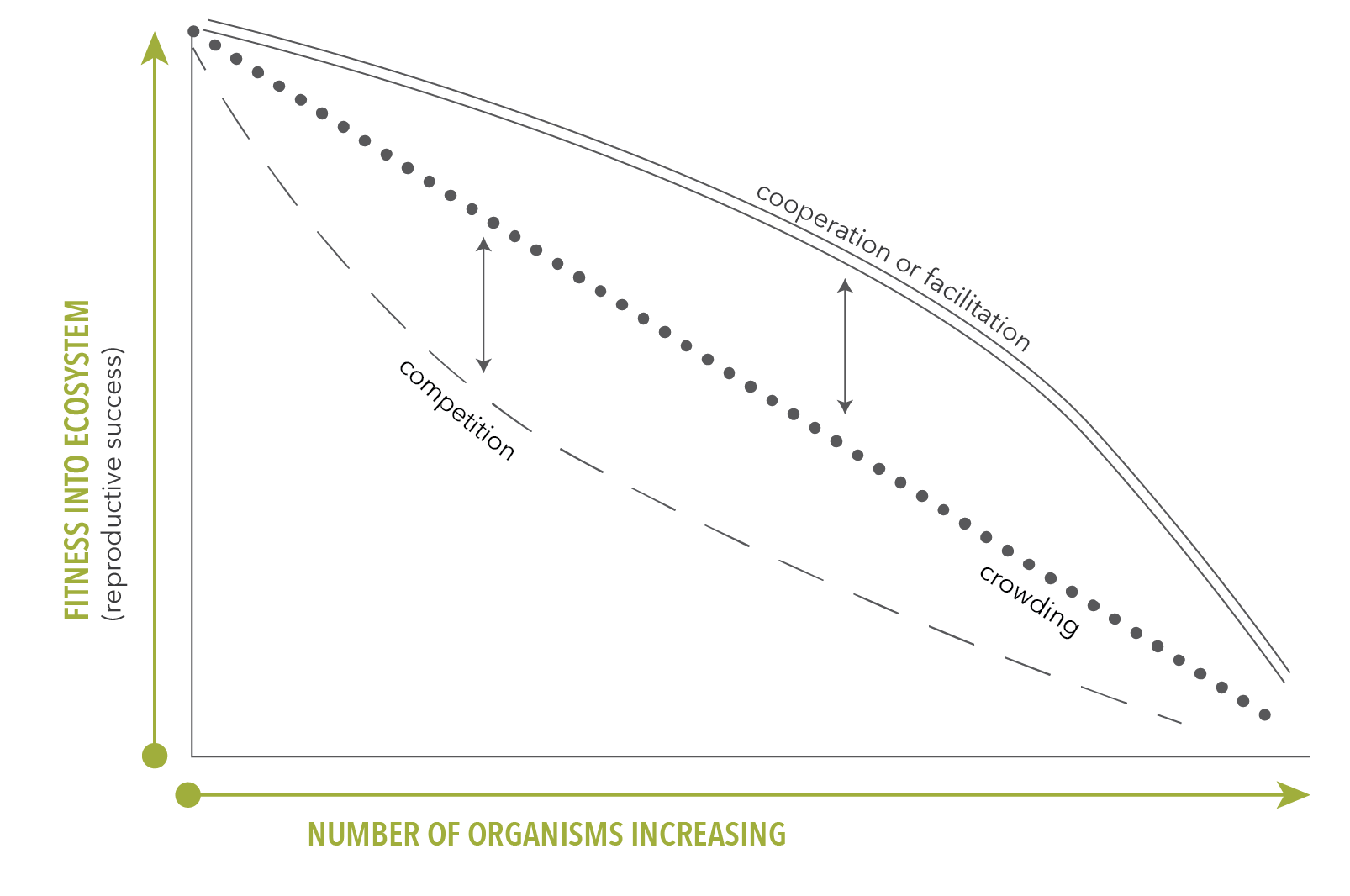The Nature of Competition
“In the ‘cut-throat’ world of business, what does nature teach us about competition?”
Dr. Dayna Baumeister, Biomimicry 3.8 Co-founder
I’ve heard this question hundreds of times over the last 20 years, not surprisingly most often from C-suite leaders constantly subject to short-term pressures. Running a business seems to be dominated by an inherent desire to win market share over competitors, so naturally leaders want to learn how to do this successfully. Yet my answer usually dismays them. It turns out, competition is incredibly rare in nature, and for good reason. Now, I have their attention, and probably yours too.
Let’s begin first with the study of competition in nature. Like virtually all of science, our collective understanding of phenomena in biology follows from what scientists have sought to understand, i.e. what they choose to study. Inevitably, cultural and personal perceptions affect where scientific research is directed, and in some cases, how the results of that research are interpreted. Ideally, the science of biology would be purely objective, but we can’t ignore that, to some degree, humans interpret their observations of the natural world according to personal experience and what they have been exposed to in their cultural system. Competition in nature is a good example of this. The interpretation of the nature of interactions between organisms has changed over time along with the cultural and sociological shifts of human experience. Statements such as Tennyson’s 1844 poetry proclaiming “nature, red in tooth and claw” and “survival of the fittest” ascribed to Charles Darwin in the 19th century resonated with social mores of the time, becoming popular memes. During this time, competition was the buzzword in business and concurrently (or perhaps coincidentally) assumed also to be the mechanism driving relationships between organisms. However, times have changed and so has our understanding of competition in nature.
"Cooperation for mutual benefit, a survival strategy very common in natural systems, is one that humanity needs to emulate."
~Dr. Eugene Odum (The father of modern ecology).
The period from the 1960s through the 1990s saw the birth of quantitative community ecology and the drive to identify the strengths of driving factors and relationships in biological systems. Much emphasis was placed on competition, but surprisingly little evidence was found. By the 1990s, ecologists came to recognize that competition is not the universal driving force that it was assumed to be. In 1997, a landmark special edition of the scientific publication Ecology focused on competition and its mirror image, facilitation. Facilitation or cooperation is a beneficial interaction between species rather than the mutually negative effect of competition. (Years ago I earned my PhD by studying how one organism, a pine, rather than competing, actually created conditions more favorable for other plant species. Facilitation was the subject of my dissertation). My research along with many other ecologists led to our current understanding that competition is only one of a suite of ways in which organisms interact with each other and actually, only occurs rarely, if at all. How could that be?
As a rule of thumb, living things avoid direct competition whenever possible namely because it is costly, resulting in reduced fitness (a term biologists use to measure success) as energy is devoted to competing rather than diversifying into new niches. As such, life evolves toward alternatives to competition, suggesting that we witness in biological systems is the avoidance of competition, rather than competition itself. But this isn’t the “word on the street”. Take, for example, the plentitude of wildlife films showing footage of two bull elk sparring during the rut in the fall to compete for opportunities to mate. (Or moose, or lions, or hippos, or bighorn sheep, there are plenty of examples!) What these 60-second clips fail to reveal are the hundreds of hours of footage of the bulls just sizing each other up. More often than not, a simple look-over by each bull preempts the match with the larger bull “denoted” as dominant. (This is why bulls form bachelor groups outside of the rut—a means to know thy potential competitor). If they do actually “lock horns”, bull elk rarely kill each other and sparring matches are usually short. One bull retreats. To the filmmaker, this is boring and never makes primetime, leaving the viewer with a skewed perception of reality.
Most examples of competition in nature exist merely as a snapshot in time, a temporary, but costly solution. Two bull elk facing off is a seasonal and intermittent behavior. Their posturing is meant to test, to push the other and see if he will yield. If so, the test was successful, if not, then another niche is sought as a remedy. Out-competing by killing all the other bull elk would mean far too many cows to manage, not to mention the energy expended and wounds one would incur in the process. Short, intermittent competitive behaviors are certainly part of healthy, functioning ecosystems, but when persistent and dominant, they become detrimental to the long-term health of the participating parties. Sound familiar?
Overall, the struggle to survive in a world of limited nutrients and riches is commonly performed in a fluid dance of push and retreat. An opponent may be tested, but the competition is broken off when it is no longer a net benefit to the organism. In contrast, interactions that benefit organisms are reinforced by evolution. Overall, organisms that have long evolutionary histories have many established interactions with others in their ecosystem and most of those interactions are non-competitive. By all accounts, competition is just too expensive of an option.
How do biologists measure the “expense” of competition in nature? Here’s one way to look at it.
On the vertical axis is a measure of fitness or how well an organism is adapted to its ecosystem (usually measured as growth rate or reproductive success) and on the horizontal-axis is the number of organisms increasing from left to right, causing crowding and interactions. [As an aside, a business might seek to be simultaneously both incredibly fit and with full market share, i.e. in the upper right corner of the graph. We call those situations monopolies, and implement policies to limit them. Is that perhaps because we recognize the system detriments of the upper right hand corner?]
The dotted line in our graph shows the effect of crowding alone and the dashed line below the diagonal, shows the effect of crowding with competition. It’s the suppression of success (the dip in the curve) that biologists use as the hallmark of competition and the vertical difference between the two lines gives a measure of how strong competition is.
The alternative to competition (the double line) is when species co-exist, or in some cases when individuals of the same species are crowded together (e.g. social organisms like ants). In these situations, they may actually have mutually beneficial effects on each other. We call this facilitation, mutualism, or cooperation. On the graph, the double line indicates individuals or species are more successful together than alone. This is, in fact, the most common observation of interactions in nature, particularly in stressful environments.
That’s right, when the going gets tough, life cooperates more and competes less. That is, the harsher the conditions, more species tend to cooperate than compete, or even to co-exist. In more benign conditions, ecologists find fewer examples of cooperation because, ostensibly, the needed benefits of a mutualistic relationship are less important for an organism’s survival.
So, when is there competition? Using this analytical tool as a model in ecological studies, competition has been documented only in artificial scenarios due to experimental design, such as creating artificial boundaries or systematically eliminating a particular species within a system. In every unaltered natural situation where organisms are attempting to use the same limited resource at the same time, their needs will only be met by encountering each other and “negotiating” the interaction. In this context, living systems have evolved toward the lowest cost way to share resources and nutrients. And what we see is that evolution to avoid competition leaves more opportunity (and energy) to grow, reproduce and diversify. In other words, to thrive.
In short, competition is not inevitable in biological systems nor in human endeavors and really is not sustainable in the long run. Competition doesn’t make you stronger; it just makes you need an alternative strategy more urgently. This is the lesson for business. We shouldn’t be asking, “how can I become a more successful competitor,” but rather “what alternatives to competition could I pursue?” My answer to business is that nature teaches us that cooperation, mutualisms, facilitation, and niche specialization are worthy of exploration. In fact, we’ve asked that very question: “How does nature foster enduring cooperative relationships?” because we know how important it is for a thriving world. In the world of biomimicry, finding closer alignment between our human endeavors and those time-tested resilient strategies of nature should remain our highest pursuit. Here’s to a less competitive and more cooperative future in business and all of our ventures.
[This piece draws from an earlier version co-written in 2009 with Robyn Klein and Janet Kübler].
In our upcoming Social Innovation workshop, you’ll discover how nature’s genius can foster a regenerative society abundant with innovative leaders.
If you would like to engage with us to apply these principles to your business start by taking our brief survey




